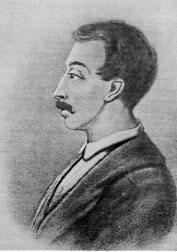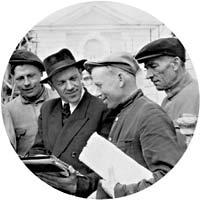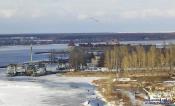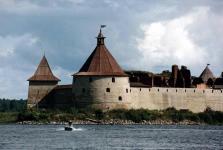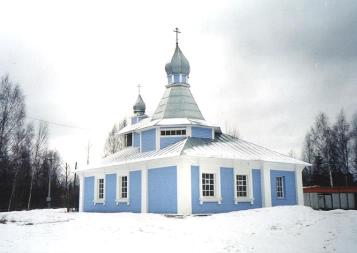Articles
/
Shlisselburg Fortress, the
Shlisselburg Fortress, the
Subject /
Architecture/Fortresses and other fortifications
The Shlisselburg Fortress (untill 1612 it is called Oreshek, from 1612 untill 1702 – Noteburg) is an ancient Russian fortress on Orekhov Island, on the Neva River where it flows out of Lake Ladoga. In 1323 Grand Prince Yury Danilovich and citizens of Novgorod built a wooden fortress with one stone tower. In the same year Orekhovetsky Peace Treaty with Sweden was signed. In 1348 the frontier post was seized by the Swedish King Magnus Erikson but in 7.5 monthes it was recaptured by Novgorod citizens. In 1352 in the eastern part of the island a stone fortress was built under the leadership of Archbishop Vasily. It was made of bouldersand flag stones in the form of quadrangle (100m by 90m) with several stone towers. The fortress plan was similar to plans of Europian castle-towns of the period before fire-arm. Inside the fortress there were dwelling houses, paved roads. In the western side of the island there was a posad which was fenced with a stone wall. In the 15th century Oreshek was the island fortress with two lines of fortifications that were separated with a canal which was adapted for berthing ships. It was governed by served princes, sometimes Novgorod boyars. During 150 years the town wasnot in danger of attack. Novgorod fortifications were pulled down in connection with the construction of a new fortress that was built by the Moscow Government from 1514 till 1525. According to the plan, the fortress, made of putilov slabs, is a polygon (300m by 150m) with 7 outside towers and inner 3-tower citadel. In accordance with requirements of the fire-arms epoch, towers are located along the perimeter of the defence line, pryaslos of walls between towers are straight, for conductin plunging fire there are 3 battle bay windows on consoles in 3 places. Originally the height of walls was 12 m, the height of 3-staged towers was 14-16 m (top parts of bonds are destroyed in 1815-1817), wall foundation thickness was 4,5 m. Walles encircled the town with paved streets and the system of water canals (the ditch around the citadel and a canal which was an inner harbour). On the Neva River banks, in the Korelian and Lopsk sides unfortified posads were built. At the 3d quarter of the 16th century the population run up to 1200-1500 people. The fortress was considered unassailable, it deflected attacks of Swedes in 1555 and 1579, but in May of 1612 after a long siege the fortress was seized by Svedes. During the Northern War Russian troops took by storm the fortress on 11 October 1702. From 1703 till 1715 earth bulwarks were constructed around towers, they were linked with curtains and faced with stones in 1741-1758. By the beginning of the 19th century the fortress lost its military importance and in 1812 it was disarmed. A posad on the left bank of the Neva River was reorganized into the town of Shlisselburg. From the beginning of the 18th century Shlisselburg was used as "tsar prison" where disgraced members of Tsar's family (Maria Alekseyevna, a sister of Peter I; Yevdokia Lopukhina, the first wife of Peter I; a former Emperor Ioann Antonovich who was killed in 1764 in the prison), disgraced courtiers (Princes V.V., V.L., I.A. Dolgoruky, D.M. Golitsin, Duke E.I. Biron), and at the of the 18th century enlighteners N.I. Novikov and F.V. Krechetov were kept. Places of detention were the soldier's ("numerical") barracks and "The Secret House" (it was built in 1798) in the citadel. From 1826 till 1834 17 decembrists (A.A., M.A., N.A. Bestuzhev, I.I. Gorbachevsky, V.K. Kyukhelbeker, A.V. and I.V. Podzhio, I.I. Pushchin) were kept in the fortress before dispatching them to Siberia. V. Lukasinsky, a figure of the liberation movement of Poland, spent almost 38 years (from 1830 till 1868) there in solitary confinement. M.A. Bakunin was kept in the Shlisselburg prison from 1854 till 1857, N.A. Ishutin was kept there from 1866 till 1868, B. Shvartse, a insurrectionist of the uprising in Poland in 1863-1864, was kept in Shlisselburg from 1863 till 1870. From 1884 till 1906 members of the "Narodnaya Volya" (M.Yu. Ashenbrenner, G.A. Lopatin, N.A. Morozov, M.V. Novorussky, M.F. Frolenko, V.N. Figner and others) and condemned to hard labour members of the Socialist Revolutionary Party (G.A. Gershuni, P.V. Karpovich, M.M. Melnikov, Ye.S. Sozonov, S.V. Sikorsky and others) were kept in the specially built solitary confinement prison ("so called "The New Prison") that included 40 cells. In all during that period 68 people were kept in the Shlisselburg Fortress, 15 of them were executed, 15 people died of illnesses, 3 people commited suicide, 8 people went crazy. From 1907 till 1917 in the fortress there was a convict central prison for which new prison building were built. In the "new Shlisselburg" participants of the revolution of 1905-1907, members of all revolutionary parties (social democrats, socialist-revolutionaries, maximalists, anarchists and others) were kept together with criminals. After the February Revolution of 1917 captives were released by insurgent workers of the Shlisselburg gun powder factory, prison buildings were burned. From 1928 till 1839 in the fortress there was a museum, a branch of the Leningrad Museum of Revolution. From the beginning of September of 1941 the Shlisselburg Fortress served as the outpost of the Leningrad front left flank and during 500 days it was subjected to all-out bombardments and raids of German aviation. In January of 1943 during the offensive on the break-through the Leningrad Siege the fortress garrison supported with the fire units which stormed the town of Shlisselburg. From 1960 the fortress is a branch of the Museum of Leningrad History (St Petersburg). Archaeological researches (A.N. Kirpichnikov from 1968 till 1970, V.I. Kildyushevsky from 1971 till 1975), restoration works (by the project of V.M. Savkov) and step-by-step museum creating have been carrying under the leadership of the museum.
Authors
Margolis, Aleksandr Davidovich
Plotkin, Konstantin Moiseyevich
Persons
Aschenbrenner, Mikhail Yulyevich
Bakunin, Mikhail Aleksandrovich
Bestuzhev, Aleksandr Aleksandrovich
Bestuzhev, Mikhail Aleksandrovich
Bestuzhev, Nikolay Aleksandrovich
Biron, Ernst Johann
Dolgoruky, Ivan Alekseyevich, Prince
Dolgoruky, Vasily Lukich, Prince
Dolgoruky, Vasily Vladimirovich, Prince
Erikson, Magnus
Erikson, Magnus
Figner, Vera Nikolayevna
Frolenko, Mikhail Fyodorovich
Gershuni, Grigory Andreyevich
Golitsyn, Dmitry Mikhaylovich, Prince
Gorbachevsky, Ivan Ivanovich
Ishutin, Nikolay Andreyevich
Ivan IV Antonovich, Emperor
Karpovich, Pyotr Vladimirovich
Kildyushevsky, Vladimir Igorevich
Kirpichnikov, Anatoly Nikolayevich
Krechetov, Fyodor Vasilyevich
Kukhelbeker, Wilhelm Karlovich
Lopatin, Gherman Aleksandrovich
Lopukhina, Evdikiya Fyodorovna, Tsarina
Lukasinsky, Valerian
Maria Alekseyevna, Tsarevna
Melnikov, Mikhail Mikhailovich
Morozov, Nikolay Aleksandrovich
Novikov, Nikolay Ivanovich
Novorussky, Mikhail Vasilyevich
Peter I, Emperor
Podzhio, Aleksandr Victorovich
Podzhio, Iosif Victorovich
Pushchin, Ivan Ivanovich
Savkov, Vasily Mitrofanovich
Schwarze, Bronislav
Sikorsky, Simon (Shimon) Wolfovich
Sozonov, Yegor Sergeyevich
Vasily Kalika
Vasily, archbishop (Kalika)
Yuri (Georgy) Danilovich, Prince
Yuri (Georgy) Danilovich, Prince
Geography
Topographical landmarks/Ladoga Lake
Topographical landmarks/Neva River, the
Topographical landmarks/Orekhovy Island
Leningrad Oblast, the/Shlisselburg Town
Bibliography
Томилин А. Шлиссельбург: Историческое обозрение шведских войн, в которых участвовала Шлиссельбургская крепость, с подробным описанием осады ее при Петре Великом. СПб., 1847
На каторжном обществе: Дневники, письма и воспоминания политкаторжан «нового Шлиссельбурга» (1907–1917 гг.). Л., 1967
Узники Шлиссельбургской крепости/Сост. Л.Б.Добринская. Л., 1978
Кирпичников А. Н., Савков В. М. Крепость Орешек: Историко-архитектурный очерк. 2-е изд., испр. и доп. Л., 1979
Кирпичников А. Н. Древний Орешек: Историко-археологические очерки о городе-крепости в истоке Невы. Л., 1980
Шлиссельбургская крепость: Очерк-путеводитель / Г. П. Игнатьева и др. Л., 1986
Игнатьева Г.П. Новая тюрьма Шлиссельбургской крепости // Краеведческие записки: Исследования и материалы. Вып. 1. СПб., 1993., С. 68–74
Игнатьева Г. П. «Нумерная» казарма Шлиссельбургской крепости и ее именитые узники // / Краеведческие записки: Исслед. и материалы. СПб., 1995. Вып. 3., С. 7–16
Игнатьева Г. П. «Новый Шлиссельбург» в воспоминаниях, дневниках и письмах узников // Труды Гос. музея истории С.-Петербурга: Исследования и материалы. Вып. 2. СПб., 1997., С. 124–137.
Mentioned in articles:
|
hidden
|
Kyukhelbeker, Vilhelm Karlovich (1797-1846), a poet
Vilhelm Karlovich Kyukhelbeker (1797-1846), poet, revolutionary(Decembrist). Upon finishing the Imperial Lyceum at Tsarskoye Selo (1817;A.S.Pushkin's classmate) served in the Ministry of Foreign Affairs and at the same time he taught Russian... more
|
|
|
|
hidden
|
Munnich, Christophor Antonovich (Burkhard Christof) (1683-1767), Count, military figure, an architect
Christophor Antonovich (Burkhard Christoph) Munnich (1683-1767), Count (1728), Field-Marshal - General (1732), a statesman and military figure. Munnich was born in Neuenhuntorf, Oldenburg, Denmark. From 1721 he was on the Russian service. C.A.... more
|
|
|
|
hidden
|
Museum of the Shlisselburf Town History, the.
The Museum of the Shlisselburg (Schlusselburg) Town History (Shlisselburg Town, Factory Island, 2a) is a municipal museum and a branch of "The Museum Agency". It was founded on 18 July of 1990. The first exposition was presented in February of... more
|
|
|
|
hidden
|
Neva River, the
NEVA, river in Leningrad Oblast and SPb. It was formed c. 3000 years ago due to a water breakthrough from Lake Ladoga to the Baltic Sea along the old valleys of the Mga and Tosna rivers. The toponym “Neva” is borrowed from the Baltic Finnish... more
|
|
|
|
hidden
|
Noteburg, see Schlusselburg Fortress
reference
|
|
|
hidden
|
Novikov, Nikolay Ivanovich (1744-1818), a literary man
Novikov, Nikolay Ivanovich (1744-1818), a writer, journalist, publisher. He attended the High School at the Moscow University during 1756-1759. From 1762 Novikov surved in the Life Guard Izmailovsky Regiment. During 1767-1768 Novikov was the... more
|
|
|
|
hidden
|
Savkov, Vasily Mitrofanovich (1907-1978), an architect
Vasily Mitrofanovich Savkov (1907-1978), an architect- restorer, researcher of the Old Russian architecture. V.M. Savkov was a founder of the Leningrad school of architectural restoration. He jointly with E.V. Kazanskaya developed the project and... more
|
|
|
|
hidden
|
Schlusselburg, town
SCHLÜSSELBURG (Petrokrepost in 1944-92), a town in Kirovsk District. In 1996–2005, a separate municipal entity. Population: 12,400. Located at the head of the Neva River, on its left bank. S. is connected by bus service to Kirovsk and St.... more
|
|
|
|
hidden
|
Shlisselburg Fortress "Oreshek", a museum
Shlisselburg (Schlusselburg) Fortress "Oreshek", a museum (Shlisselburg Town, Oreshek Island), is a branch of the State museum of the history of Sankt Petersburg from 1965. The museum was founded in 1925 and it was presented for visitors, as a... more
|
|
|
|
hidden
|
Trezzini, Dominiko (ca. 1670-1734), an architect
Dominiko Trezzini (ca. 1670-1734), an architect. He was of Switzerland origin. He arrived into Russia in 1703. The stone Peter and Paul Fortress, SS Peter and Paul Cathedral, the Summer Palace of Peter I in the Summer Garden were built and... more
|
|
|
|
hidden
|
Urban settlement named after Morozov
NAMED AFTER MOROZOV, an urban settlement in Vsevolozhsk District. Population: 10,700. Located on the right bank of the Neva near its source, opposite to the Oreshek Fortress. The St. Petersburg-Nevskaya Dubrovka railway branch extends near this... more
|
|
|
|











